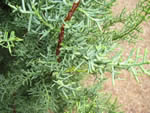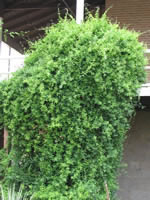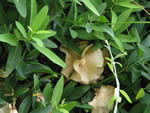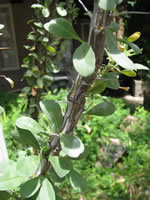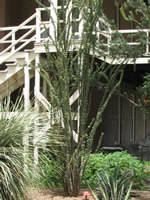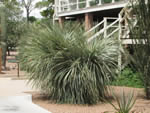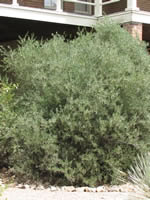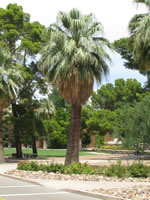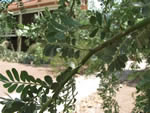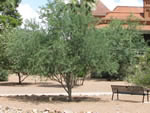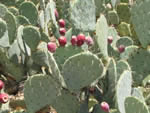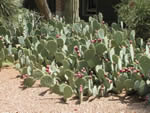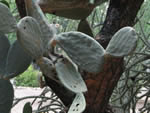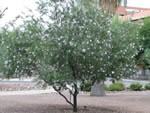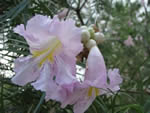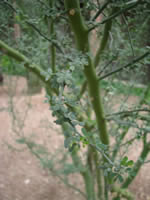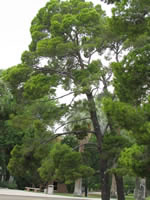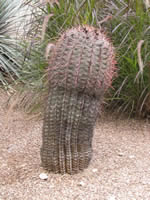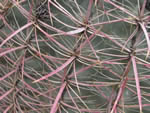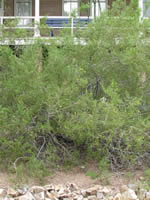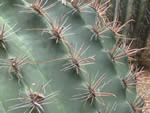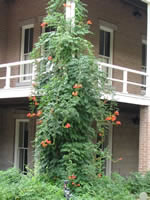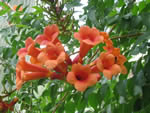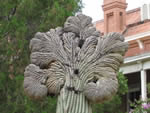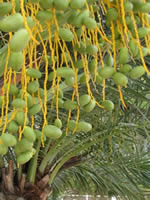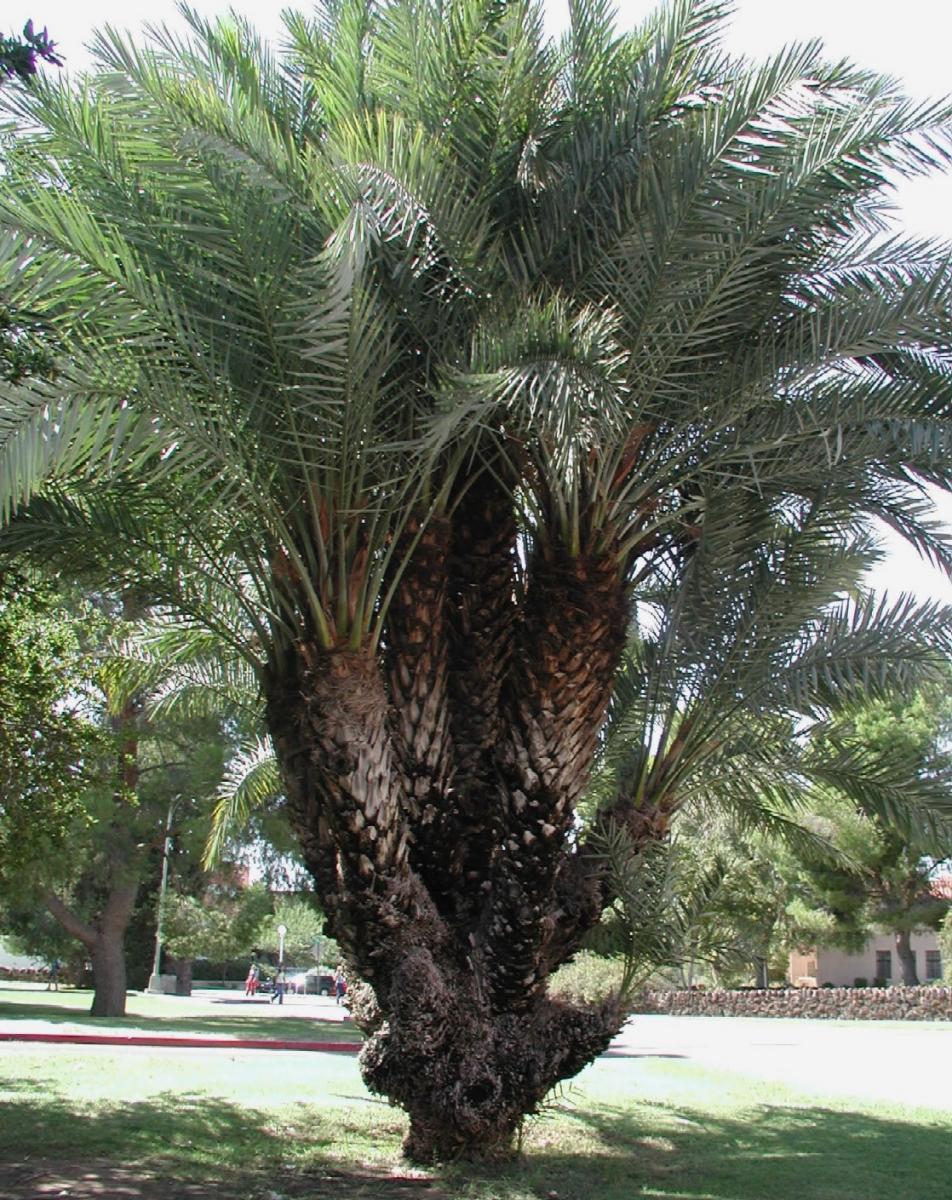Old Main Tour
Old Main Plant Walk

Plant Walk I is a short walk, encircling Old Main clockwise, starting from the steps on the east side. Many important natives of the Sonoran Desert are planted here, along with other interesting plants. As will be the case for all Plant Walks, there are many more plants out there than are included. Feel free to contact the Herbarium if any spark your interest.
The following plants are included in Plant Walk I; numbers refer to the descriptions that follow. The scientific name (Genus species) is given in italics, followed by the common name in parentheses.
1- Prosopis velutina (Velvet mesquite)
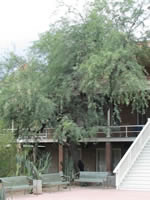
 click on images to enlarge.
click on images to enlarge.
Location: near the building; a tall tree shading the corner
Family: Fabaceae, the legume family
Distribution: common in southern Arizona and Sonora, up to 1400 m (4600 ft) in elevation
Habitat: along watercourses in the desert, sometimes forming woodlands in slightly mountainous areas
Habit: small to large tree
Flowering: spring, often again in summer
Natural history notes:
Prosopis is a genus of spiny trees and shrubs found in warm regions, primarily of the New World. The paired spines, positioned at the base of leaves, may serve to protect the mesquites from large herbivores. The historical expansion and reduction of the velvet mesquite woodlands, up desert mountain sides and back down, as now, to primarily watercourses, is documented for the last 12,000 years using evidence from pack-rat middens. Pack-rats carry many plant parts back to their nest; under the right circumstances these clues to historical plant distributions can then be preserved for thousands of years, as has been the case for velvet mesquite. Velvet mesquites flower in the spring and may flower again in the summer, if the rains are sufficient. The flowers are tiny, but a few hundred are produced together in a spike, offering a rich nectar resource for insect visitors. The fruit of the mesquite is a dry pod, and is enjoyed by livestock who then spread the seeds. This and the suppression of fire have encouraged the mesquite to expand into grasslands, transforming them into woodlands.
Distinguishing characteristics:
The leaves are compound, that is, leaves are comprised of separate leaflets. In fact, mesquite, like its relatives, has doubly compound leaves - the leaflets themselves are made up of several leaflets. Mesquites have small regular flowers, clustered together in dense yellow spikes. Prosopis can be told by its 1 or 2 pairs of primary leaflets (each of which are comprised of many small leaflets) and flowers with 10 stamens. Pods of the velvet mesquite are straw colored, sometimes with red streaks, flattened, and 10-20 cm long. Two other mesquites occur near Tucson, differing by larger, more widely spaced leaflets (honey mesquite), or pods tightly coiled (screwbean mesquite).
Ethnobotany:
Mesquite, a mainstay of local peoples, has been very important as fuel wood, for construction, and as an important food source. The pods of the velvet mesquite contain starches and sugars, and are ground to make a flour, and gum exuded from the bark makes a candy, mends pottery, and produces a black dye. The inner bark is used in basketry, fabrics and medicine, and bees visiting mesquite produce excellent honey.
2- Aloe barbadensis (African Aloe)

 click on images to enlarge.
click on images to enlarge.
Location: covering the ground near the sidewalk; foot-high plants of fleshy pointed leaves
Family: Asphodeleaceae, the aloe family
Distribution: South Africa
Habit: rosette of succulent, pointy leaves
Flowering: 2 or 3 times per year; patches of the plant are rarely completely out of flower
Distinguishing characteristics:
The commonly cultivated African Aloe is striking in its green or pale green leaves, tinged red, and with dull white spots. Along the edges of the leaves are tough brown teeth. When flowering, purplish stalks rise well above the leaves, bearing reddish or yellowish flowers. These flowers are probably pollinated by small birds, which, however, would not be hummingbirds: the plants are native to the Old World, where there are no hummingbirds. The remarkable similarities among flowers pollinated by different birds on different continents provide an excellent example of convergent evolution.
Ethnobotany:
The African Aloe is an attractive landscape plant that flowers frequently and profusely. It is related to Aloe vera, now widely used in lotions and shampoos.
Location: right at the SE corner of Old Main's East wing; tall tree having many reddish main branches emerging from near the base
Family: Cupressaceae, the cypress family
Distribution: Endemic to central Arizona near the Mogollon Rim, 1100-1700 m (3500-5500 ft) in elevation
Habitat: canyon bottoms
Habit: tree to 70 ft
Natural history notes:
Cypresses are not flowering plants, but conifers, or cone-bearing plants. The family Cupressaceae also includes cedars, bald cypresses, and redwoods, but not pines, firs, or yews. Arizona cypress is found only in protected canyons and is indicative of a healthy riparian community. The variety glabra is peculiar in that it sheds its bark annually, leaving only the smooth red inner bark. This variety only grows in a few places in the Mogollon rim area of central Arizona, where it is the only cypress to be found.
The cypresses can be told by the small, scale-like, appressed leaves, which often bear glands; these give off a pleasant odor when crushed. The cones distinguish cypresses from junipers; in cypresses, the cones are globose and woody, whereas in junipers the cones are more fleshy (juniper berries!). The Arizona Cypress, to which the Smooth-barked Arizona Cypress is related, is the only other local cypress and has a rough, more typical cypress bark.
Several varieties of the Arizona Cypress are planted as ornamentals, and it is said to be used in land reclamation in France and Northern Africa. The spanish word for cypress, Sabino, is a common location name, including Sabino Canyon in the Santa Catalina Mountains, just northeast of Tucson.
Family: Malpighiaceae, the malpighia family
Distribution: Central Sonora and Baja California south throughout México
Habitat: rocky washes, hillsides, sandy plains
Habit: robust vine
Flowering: following rains in spring and summer
The New World members of this medium-sized family have oil glands on the flowers, which attract oil-collecting bees. Another malphig, Janusia gracilis, is a common desert vine found all around Tucson; though much more slender and with a different fruit, its smaller flower is very similar in shape to the flower of Callaeum, described below.
The malpighia family is strongly marked by flowers of 5 spreading petals with long narrow claws (stalk-like basal portions of the petals) and fringed or wavy margins. The sepals are held erect, between the claws of the petals, and bear oil glands (in the New World). The family consists of woody plants, often vines, with usually opposite leaves. The genus Callaeum is distinguished by having broadly winged fruits, each section of which has multiple wings and by having two round glands at the base of the leaf blade, small but usually visible on this plant. The fruits of Callaeum macropterum have exceptionally large, papery wings, from which it gets its name, ('macroptera' translates as 'large wing').
Family: Fouquieriaceae
Distribution: patchily common from Southern California to Texas, through Northern México; up to 1900 m (6200 ft) in elevation
Habitat: gravelly hillsides, especially limestone, some sandy plains
Habit: large shrub branching mostly at base
Flowering: spring
Ocotillo, despite its spiny appearance, is not a cactus. With its long, ascending, spiny stems branching mostly at the base of the plant, the ocotillo, or coach whip, is an unmistakable resident of the Sonoran Desert. Found throughout the southwest U. S. and northwest Mexico, it is common on gravelly hillsides and sandy plains. The plants are usually leafless; leaves are produced only when water is available to the stem. When water is no longer available, the leaves fall off. Leaves on new branches leave behind only a portion of the base of the leaf; these harden and become the prominent spines. Blooming in spring, the ocotillo produces splendid (hence the species name) stalks of many bright red tubular flowers that attract many local and migratory hummingbirds as well as other visitors.
Related species occur in different parts of the Sonoran Desert; our local ocotillo is the only one without a definite trunk. A related plant, the Cirrio or Boojum has a massively swollen trunk and therefore appears to resemble the ocotillo little; however, very young ocotillo plants have distinctly swollen bases, making the relationship more apparent.
Ocotillo branches have long been used to make spiny fences, providing protective runs and corrals for livestock. Cut branches can actually root; the fence then becomes alive, sprouting leaves in response to rains. The stems have a wax coating that has been used as a dressing for leather, and a concoction made of the roots is said to be relief for fatigue and swelling.
Family: Nolinaceae, the beargrass family
Distribution: common in Southwest United States and Northern México
Habitat: grasslands, oak woodlands, and bajadas
Habit: large terminal rosette with short woody trunk
Flowering: May - July
Sotol has long flattened, often bluish leaves, with reddish-brown spines along the margins which point in the direction of the leaf tip. The large clump of leaves and 'skirt' of dead leaves usually completely obscure the trunk. Tall flowering stalks emerge from the apex of the plant bearing drooping branches of small white flowers and, eventually, dry fruits.
This historically important desert plant is endemic to and found throughout the arid uplands of southwest US and Mexico. Sotol hearts are used as food and in the distillation of a tequila-like beverage. Fibers from the long leaves are used as basket material.
Family: Simmondsiaceae, the Jojoba family
Distribution: SW US, NW Mexico; abundant.
Habitat: rocky slopes and hillsides, along washes
Habit: dense shrub
Flowering: Feb - Apr
Natural history notes:
Jojoba is an abundant and distinctive resident of the Sonoran desert. The jojoba plant is so distinct that it is alone in its genus and family, and its closest relatives are unclear. The plant is dioecious, so individual plants are either male or female. It is more common, in flowering plants, to have both the male and female parts together in one flower, rather than on separate individual plants. Male plants produce flowers with copious amounts of pollen which is carried by the wind to nearby female plants. A jojoba's gender can easily be told by the structure of the inflorescence; male flowers are produced in clusters whereas female flowers are produced singly.
Jojoba is easily told from other desert shrubs by its rounded gray-green leathery leaves, produced in opposite pairs and held characteristically erect. This positioning of the leaves is thought to be an adaptation to the extreme desert sunlight; it functions to reduce the angle of incidence of the sun's radiation, thereby reducing the amount of energy absorbed.
Fruits of the jojoba are single-seeded capsules and were used by the Seri people in coastal Sonora and early settlers for soaps, medicines, and a brewed coffee-like drink. The nuts themselves are also edible, but bitter. The seed contains an oil that is similar to sperm whale oil; it became commercially important after the ban on whale hunting in 1972. The oil, which is actually a liquid wax, has been used in industry for electrical insulation, phonograph records, and varnishes.
Family: Arecaceae, the palm family
Distribution: south-central California, northern Baja California, outliers in Arizona and Nevada, up to 700 m (2300 ft) in elevation
Habitat: canyons with permanent subsurface flow, springs; commonly cultivated
Habit: large single-trunked tree
Flowering: spring
California fan palm is also called Petticoat palm, a name earned by its tendency to retain many layers of old dead leaves around the trunk. This may protect the growing part of the trunk from freezing. The fruits of the fan palm are unpalatable to humans, but feed many animals, including coyotes, foxes, and birds. Though it lives in highly isolated populations, in rare desert 'oases', it has been found that populations are genetically very similar, perhaps indicating long-distance travel of the animals eating the fruits.
California fan palm has, as its name implies, fan-shaped leaves. To distinguish it from other fan-leafed palms, notice the stout trunk (to 1m in diameter) and that the tips of the gray-green leaves droop, at least the horizontally held ones. The specific name comes from the many threads that peel off the leaf margin.
Family: Fabaceae
Distribution: Arizona , Mexico , SE California - from sea level to 3000 ft
Habit: Tree
Flowering: late spring (May in Tucson ) purple flowers
Trees grow to 25 ft tall, slow growing and long lived. Bark is gray to white, and sheds. Leaves and twigs are covered with small hairs, which serve to protect the tree from the worst of the hot sun. Leaves are dull green, divided into 6-16 leaflets. Small spines can be curved or straight. Flowers are pea-shaped and pale pink to purple. Dark brown 2” seed pods develop in June - July in Tucson.
Ironwood trees are the source of very dense hard wood (which burns hot and does not float). Native cultures in both Arizona and Sonora made use of the wood for building and carving of bowls, etc. Ironwoods are “nurse” trees in the Sonoran Desert . Animals gather in the shade during the hottest months, and other cacti and small shrubs utilize the tree's canopy to shelter from the sun. Like other members of the family, Ironwood is a tree that gathers nitrogen from the soil, so leaf litter and seeds are particularly rich in nutrients.
Family: Cactaceae, the cactus family
Distribution: California to Nebraska, through Northwest México
Habitat: most common in semidesert grasslands and oak woodlands
Habit: semi-erect jointed succulent
Flowering: April, May
Opuntias are cacti, as can be seen by the succulent body form, usually absent leaves, and presence of spines. In addition to the large, more noticeable spines, spines, opuntias have glochids - many tiny fiberglass-like spines, which are definitely to be avoided! A characteristic of the genus is to have the body of the plant formed of several sections, or joints. Each of these joints is capable of rooting if broken off, and many opuntias reproduce in this way. The prickly pears have flattened joints, like pancakes stacked on edge. The chollas, also seen around Old Main, and also in the genus Opuntia, have cylindrical joints. Though perhaps not apparent, cacti usually do have leaves: opuntias have chubby little leaves, seen only on new joints, that eventually wither and fall off. The showy prickly pear flowers only stay open for 1 day, offering rich resources for insect visitors. If you happen to see an open flower, carefully touch the dense field of stamens in the flower - they will slowly curl in towards the center, as if trapping an insect! Many animals eat the fruits and disperse the seeds, including bear, tortoise, and coyote, and the javalina will eat the fruit and the prickly pads.
Engelmann prickly pear has rather large pads, with white to ashy gray spines that tend to point downward. Though more horizontal in growth form than Indian "fig" (see #12, below), this prickly pear can get up to 4' tall and form a sprawling thicket.
Prickly pear fruits, including the widely distributed Engelmann prickly pear, have been a reliable and delicious source of summer food for local people, and are now also used commercially in jam and candy making. The despined pads are used in salads and as pickles (nopalitos).
Family: Cactaceae, the cactus family
Distribution: probably originally from México, now widely cultivated
Habitat: naturalizing in warm arid areas
Habit: tree of flattened joints, to 12 feet or more
The spineless cactus, as the name implies, usually has no large, visible spines as do other prickly pears in the area. Beware, however, because the spineless cactus does have glochids, tiny spines that brush off into your skin. Too small to remove individually, these spines must simply be endured until they wear out.
Distinguishing characteristics:
Spineless cactus, though not the only prickly pear without major spines, is easy to distinguish by its large woody trunks and ability to grow to great heights. The smooth flat joints identify it with the prickly pears (see #12). The flowers, born along the upper margins of the pads, are yellow; the fruits are variously colored.
The edible fruit has been exported to Europe as "Indian fig", a misleading common name because true figs belong to the genus Ficus (Moraceae), a totally unrelated plant group.
Family: Bignoniaceae
Distribution: SE California to SW Utah to New Mexico and Texas ; Central Sonora
Habit: Tree with several trunks
Flowering : nearly continuously from March to November
Soft green leaves, shiny on top, slightly drooping Warren Jones, Professor Emeritus of Landscape Architecture at the UA, found and developed this particular variety, valued for its evergreen foliage. Others found in the wild are winter deciduous. Seed pods are long and “bean like” but open to release papery seeds. . Flowers can be various shades of purple and pink. They have a prominent lower “lip” that guides bees to nectar.
Ethnobotany:
Desert Willow is a well-used tree in southwestern landscapes. Although it is native to stream beds and arroyos, it can perform beautifully with medium to low irrigation. Many named varieties are in the nursery trade.
Family: Fabaceae, the legume family
Distribution: Southern Arizona through northern Sinaloa, to Baja California
Habitat: roadsides and arroyo margins
Habit: medium sized tree
Flowering: March - April
Natural history notes:
As is true of many of the plants that make up the Sonoran Desert flora in the Tucson area, the blue Palo Verde is thought to have arrived relatively recently, approximately 4240 years ago, according to pack-rat midden evidence (see discussion of pack-rats under #2). Before that time, communities such as juniper woodland came and went in the climatic cycles associated with the Ice Ages. The trees are profuse bloomers, densely clothed in bright yellow flowers for a few weeks in late spring. Bees are the most common pollinators, including the honeybee, itself a far more recent introduction to the desert, having arrived to the New World with Europeans.
The blue palo verde can be told from other green-trunked trees by its small straight spines at the branching points, the bluish tinge to the green bark and leaves, and its tendency to grow near washes in the wild (as opposed to the Foothills palo verde, which tends to grow on slopes). The Blue palo verde also flowers earlier than the Foothills palo verde. Both are found throughout the Tucson basin. Leaves of the palo verdes are small, compound, and drought deciduous, only reappearing again after the summer rains start.
The seeds, flowers and immature fruits (pods) were all eaten by local peoples.
Family: Pinaceae, the pine family
Distribution: Mediterranean
Habit: large tree
Aleppo pine, like all pines, is a conifer, not a flowering plant. Pines reproduce with seeds, just like flowering plants, but the seeds are borne in cones instead of flowers and fruits.
The pines are easy to distinguish from other conifers (or "evergreens") because the needle-like leaves are grouped in bunches. When they fall, they fall as a unit (you can see many such bunches on the ground). Aleppo pine is characterized by 4" leaves, in bundles of two.
It is thought that Aleppo pine may have been the first Christmas tree. In Greece, Aleppo was decorated in a tribute to the god Attis; the early Christians may have adopted this ritual in the celebration of Christmas. Aleppo is a commonly cultivated pine in warm arid areas, as it tolerates heat better than many conifers. It is also used as a source of turpentine.
Family: Poaceae, the grass family
Distribution: originally African, now widespread
Habit: herb
Fountain grass is a beautiful plant that tolerates heat and aridity while still looking good. It produces fluffy pinkish inflorescences at the apex of the graceful flowering stalks. Unfortunately, it is also highly invasive. That is, especially in wet years, it spreads into the desert where it competes with native plants. Worse, in dry years, the plants can burn spreading fire in the desert where native plants are not able to survive even a light fire.
Distinguishing characteristics:
Fountain grass grows in clusters; new grass plants emerge from the base of old ones, forming a tight bunch. Eventually, the old ones in the center die, leaving a ring of living grass.
Family: Cactaceae, the cactus family
Distribution: Utah through California, to Sonora and Baja California
Habitat: gravelly hillsides, wash margins, canyon walls
Habit: robust columnar cactus
Flowering: late spring - early summer
Natural history notes:
The barrel cacti, like other columnar cacti, have an internal skeletal system comprised of woody ribs. From the outside the ribs look like ridges, along which the spines are borne. Ribs allow the body of the cactus to expand easily when water is plentiful, so the spongy tissue between the ribs serves as a long-term water storage system. Ants crawl actively over the top of the barrel cacti, which offer nectar in places right on the body of the cactus, so the ants can be fed even when the flowers are not available. It is possible that the ants are providing some kind of protection service to the cactus, which has made it advantageous to the plant to keep feeding the ants. Though the obvious use of spines is as protection against herbivores, it has also been shown that the presence of spines greatly reduces surface temperature, so the California barrel's density of spines may be its personal shade cloth.
The California barrel has many spines, often reddish in color. The large central spine is usually flattened and may be somewhat hooked at the end, though not as strongly as in the Arizona barrel (see #20, below). As the Latin name implies, these barrels tend to be more cylindrical than truly barrel-shaped.
The pulp of the California barrel is unpalatable but can be used in desperation as a source of water. Bighorn sheep eat the tissue during seasonal droughts. The seeds were ground into a gruel by the Seri.
Family: Zygophyllaceae, the caltrop family
Distribution: throughout the warm North American deserts, from Nevada to central México, up to 1600 m (5200 ft) in elevation
Habitat: semi-desert grassland, chaparral, thornscrub, desertscrub, conifer woodland
Habit: slender-branched shrub up to 3.5m
Flowering: any time following rain, even in winter
Creosote is one of the most prominent plants in our deserts, covering thousands of square miles, often in pure stands, often with plants of equal size. Most closely related to Larrea divaricata of South America, it has been hypothesized that our creosote came up from South America before the more than 11,000 years ago, moved into the Chihuahuan desert, from there to the Sonoran Desert, then to the Mohave Desert. Creosote is very well adapted to heat and drought, surviving in places where apparently little else can. It has an extensive root system, much of it very shallow, and chemicals exuded by the roots are known to inhibit some other shrubs' roots, including creosote, which may in part explain the stands of evenly spaced plants. A slow grower, it takes at least 13 years for reproductive maturity. New stems arise from the base of the plant at the outside edge, and when old stems eventually die (after 40-90 years), a space is created in the middle. In this way, clones of single plants form rings, the largest and oldest of which are estimated to be 11,700 years old. Over 40 insects are known to be wholly or partly dependent on creosote.
Creosote is easily recognized by the tough small tough leaves, resinous when young, formed of two leaflets fused together at the base. The contrasting bright yellow flowers can appear any time a good rain occurs, followed soon by white fuzzy ball-shaped fruits which tumble along the desert floor in the wind. The thin gray stems are jointed and swollen at branching points.
The resinous secretion (lac) of a scale insect that attacks creosote was used by Seris as adhesive. In addition, many parts of creosote have medicinal uses. Creosote resins are reported to be used as agricultural fungicides. Flower buds are pickled and eaten like capers.
Family: Cactaceae, the cactus family
Distribution: Southern Arizona to Texas, sporadically through Northwest México
Habitat: rocky or sandy hills, flats, or arroyo margins
Habit: robust columnar cactus
Flowering: mid - late summer
Another common name for the arizona barrel is "compass plant" - many individuals in the wild lean, quite noticeably, to the south. The function of such a tilt is not well understood. It is thought that it may serve to heat up the top of the plant, stimulating flower development, or it may be a result of slower growth on the south side, due to an excess of heat.
The central spine of the Arizona barrel is flattened and strongly fish-hooked, differentiating it from the California barrel (see #17). The Arizona barrel also tends to be more barrel-shaped, bowing out at the sides, than does the California barrel.
The succulent tissue has been used in candy making and as a source of drinking liquid. The flowers and seeds were eaten by the Seri people, who also used the hollowed out cactus bodies for honey storage.
Family: Bignoniaceae, the trumpet vine family
Distribution: Pennsylvania to Florida and Texas
Habit: woody vine
Flowering: spring and summer
Trumpet vine is a large lush vine that grows well here if watered. The vine anchors itself to its support by growing small roots along the stem.
The leaves of trumpet vine, like most members of the trumpet vine family, are opposite, i.e., two leaves are attached to the stem at the same point but on opposite sides. The leaves are also compound (comprised of separate leaflets). Trumpet vine's leaves are a rich green, the leaflets have teeth along their margins, and are pointed at the end. Flowers of the trumpet vine are strikingly orange and red, long, and tubular out to the "lips" which flare, inviting pollinators. Inside the flower, two pairs of stamens arch over the roof of the tube, ready to brush the tops or backs of insect or hummingbird visitors.
Trumpet vine is commonly cultivated for its ornamental value.
Family: Cactaceae, the cactus family
Distribution: common, central Arizona through southern Sonora, to 1100 m (3500 ft) in elevation
Habitat: rocky slopes, sometimes sandy flats
Habit: large columnar cactus
Flowering: primarily May
The saguaro is Arizona's largest columnar cactus, representing a growth form that is much more abundant and diverse in México. Many westerns have been filmed around Tucson; this, in addition to its appearance on many "Old West" products, has given the mistaken impression that saguaros are ubiquitous. The saguaro, however, is found only in the Sonoran Desert, from southern Sonora to central Arizona, where summer rains provide needed moisture at the peak of stem growth. The large, white, waxy flowers each last just 24 hours. At night, bats visit the flowers for the nectar and serve as pollinators; during the day many additional visitors transport pollen, including the white-winged dove. When ripe, the fruits burst wide open displaying the bright red pulp and multitudes of tiny black seeds. The pulp serves to attract animals, who then distribute the seeds. Young saguaros are often found associated with shrubs or trees; these plants may serve as "nurse plants", shielding the tender cactus from the harsh sun or occasional frosts until it's large enough to withstand such pressures. Even when adult, however, a saguaro can become sunburned if transplanted with its north side facing south. A slow grower, the saguaro takes three decades to reach sexual maturity and can live up to 200 years. By the time it reaches 4-5 meters, the plant is 50-70 years old and is finally ready to start developing branches. Flickers and gila woodpeckers build their nests in the stems of the saguaros; these holes are then used by may other creatures for nest sites, including the rare pygmy owls. The cactus forms a thick tissue to surround the burrow, and, as long as there are few enough such holes, remains healthy. These burrows are called saguaro "boots", and can be found lying on the desert floor long after the saguaro that made it is reduced to a pile of long wooden ribs.
The saguaro is the only large single-trunked cactus in the United States. When young, they can resemble other cacti but can always be told by their short (as compared to those of barrel cacti) straight gray spines. The saguaro is also the only member of the genus Carnegiea, but other large columnar cacti can be found not far south of the border. The cardón resembles the saguaro but is even more massive, and produces flowers much further down the columns than the saguaro, which flowers only at or very near the apex of the trunk and branches.
The saguaro has been and is extremely important to the peoples of the Sonoran desert. The fruits are produced each summer, regardless of drought, making it a timely resource to traditional desert dwellers. The delicious fleshy fruits are collected with long poles and made into syrups and jams; the seeds are made into a butter or used in cakes. Arizonan settlers have also revered the saguaro by making it the state flower and by planting it commonly within the cities and towns of southern Arizona.
Family: Agavaceae, the century plant family
Distribution: Southeast Arizona to West Texas, Chihuahua and Sonora, up to 6000’
Habitat: desert grasslands
Habit: trunked, often branched rosette
Flowering: May - July
Yuccas of the southwest have a unique pollination story. Females of one particular moth species mate, take pollen from one yucca plant, fly to another, lay eggs in the yucca flower, then pack the pollen onto the stigmas of the flower. The moth is both harming the yucca, because the developing larvae eat seeds, and helping the yucca, because the mother moth ensures that the flower is pollinated. This is considered a classic and important case of a mutualism, where both partners in an interaction benefit - the moth benefits by having food for its young, and the plant benefits by having a reliable pollinator. This sort of interaction works as long as the cost is not too great to either partner. Some seeds must remain unharmed and it must not endanger the moth too much to spend its time gathering and delivering pollen.
Yuccas are distinguishable by their tough and fibrous leaves, less succulent than agaves. The soaptree yucca is trunked and has narrow, fibrous leaves. Flowers of the yuccas are large, white, waxy, and cup-shaped, and the fruits are hard capsules that split into three segments.
Roots of the soaptree yucca produce amole, a detergent used in manufacture of shampoo and soap. Leaf fibers are used for jute, young flower stalks and lower stems are edible, and the edible flowers are rich in vitamin C.
Family: Arecaceae, the palm family
Distribution: probably originally in West Asia and North Africa
Habitat: desert
Habit: single or multiple trunks, topped with crown of large leaves
The date palm was one of the earliest plants to be cultivated by humans, starting approximately 6000 years ago. It has been the staple for nomadic peoples in Arabia and North Africa, producing edible fruits (dates!) and useful fibers from the leaves.
The leaves of the date palm are long and feather-shaped, in contrast to palms whose leaves are fan-shaped (for example, #9). The trunk is rough and gray and reaches 18 inches in diameter, making it more slender than other commonly cultivated feather-leafed palms. Single trunks can reach 100 feet tall, and offshoots are produced next to the main trunk, making the natural form of the date palm a clump of several trunks, as seen Northeast of Old Main. This tree is a UA Heritage Tree.
Now that you've taken a tour of this very small portion of campus, we hope you're inspired to continue your botanical explorations of other areas.
We invite you to explore the UA Arboretum again in person or in the cool dimly-lit environs of cyberspace via virtual tours offered on our website http://arboretum.arizona.edu/tree_tours. The campus is open 7 days a week, absolutely free. Many trees are labeled, and more signs are being made.
During business hours M-F 8-4pm, you may pick up self-guided tour booklets of the UA Arboretum available for loan from Herring Hall. Pima Co. Master Gardeners also offer docent-guided tours several times each month throughout the academic year (August through April). There is much botany and a rich state history to learn from this living laboratory. We look forward to greeting you.
Contact the UA Campus Arboretum (email: infoarboretum@ag.arizona.edu or phone: 621-7074 or 621-1582) for general questions regarding campus (or any) plants, and for access to the references used to make this plant walk.


